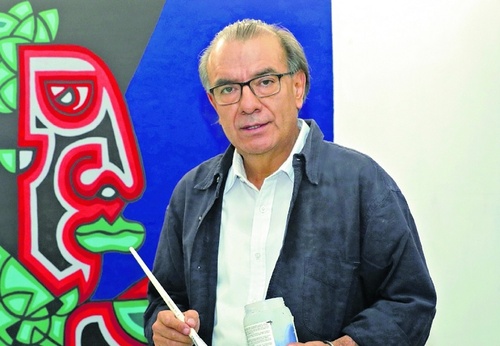
14 questions and answers about the art of painting
1. How can the art of painting convey emotions?
Painting is a unique form of expression, capable of conveying emotions in different ways. Through colors, textures and shapes, the painter can create an atmosphere that awakens feelings in the viewer.
2. What is the importance of colors in painting?
Colors play a fundamental role in painting, as they are able to evoke different emotions. Warm colors like red and yellow can convey passion and energy, while cool colors like blue and green can convey calm and serenity.
3. What are the most exciting painting styles?
There are several styles of painting that are known to convey intense emotions. Expressionism, for example, seeks to portray the artist's inner emotions through vigorous brushstrokes and vibrant colors. Surrealism, on the other hand, uses fantastic elements to create images that awaken feelings of mystery and surprise.
4. How can the painting technique influence the emotions conveyed?
The technique used by the painter can also influence the emotions conveyed by the work of art. Fast, loose strokes can convey energy and movement, while soft, gentle strokes can convey tranquility and delicacy.
5. How can painting be used as a form of emotional therapy?
Painting can be a powerful emotional therapy tool, allowing the individual to express their emotions creatively and non-verbally. When painting, it is possible to release pent-up feelings and find emotional relief.
6. What are the emotional benefits of practicing painting?
The practice of painting can bring many emotional benefits, such as stress relief, increased self-esteem and improved concentration. In addition, painting can also help in the development of creativity and personal expression.
7. What is the importance of originality in painting?
Originality is essential in painting, as it is through it that the artist manages to convey his unique vision of the world. Each painter has his own style and his works are like an extension of his personality.
8. How can painting be a form of universal communication?
Painting is a universal form of communication, as it does not depend on words to convey messages. A work of art can be understood and appreciated by people of different cultures and languages, as the emotions it arouses are universal.
9. What are the main characteristics of emotional painting?
Emotional painting is usually characterized by expressive brushstrokes, intense colors and themes that evoke deep feelings. She seeks to convey the essence of human emotions through art, touching the viewer's heart.
10. How can painting be used to express difficult feelings?
Painting can be a safe and effective way to express difficult feelings such as sadness, anger or fear. By putting these emotions on paper, the artist can process them and find some emotional release.
11. What are the most famous paintings that convey emotion?
There are several famous paintings that are known to convey intense emotions. Some examples include “The Scream” by Edvard Munch, which portrays deep anguish, and “The Starry Night” by Vincent van Gogh, which conveys a sense of beauty and melancholy.
12. How can painting make us reflect on our own emotions?
When contemplating an emotional painting, we can identify with the emotions depicted and reflect on our own experiences. Art invites us to look inside ourselves and connect with our deepest feelings.
13. What is the importance of painting in culture and history?
Painting has played a fundamental role in the culture and history of mankind. It records important moments, portrays historical figures and expresses the emotions and ideas of different eras. In addition, painting is also a way of preserving the collective memory of a people.
14. How can painting help us appreciate the small emotions of everyday life?
By looking at a painting, we can learn to appreciate the small everyday emotions that often go unnoticed. Through art, we are invited to look at the world with more attention and sensitivity, valuing every moment and every feeling.


- July 15, 2025
Shot in the foot

- July 15, 2025
Differences between modern art and contemporary art

- July 15, 2025
Rudy Cottón Exhibition in Guatemala

- July 15, 2025
Gallery Of Humor Drawing By Naser Jafari - Jordan_Part2

- July 15, 2025
Exhibition of a Legend of Latin American Visual Art

- July 15, 2025
Gallery Of Street Art By Bryan Molina - Mexico

- July 14, 2025
An exhibition that says nothing

- July 14, 2025
Visual Techniques in Advertising Photography

- July 15, 2025
How does Artificial Intelligence help d…

- July 15, 2025
Differences between modern art and cont…

- July 14, 2025
Visual Techniques in Advertising Photog…

- July 14, 2025
Graphic Design and the Creation of Icon…

- July 13, 2025
Latin American painting

- July 13, 2025
Culture, art and music in Colombia

- July 10, 2025
The Evolution of Graphic Design from Ty…

- July 10, 2025
How Digital Artists Collaborate with Ar…

- July 09, 2025
The Value of Art in Education

- July 09, 2025
Art as a Reflection of Society

- July 08, 2025
The history of Bolivian art

- July 08, 2025
Protecting Art in the Age of Artificial…

- July 04, 2025
Graphic Design and Creating Iconic Bran…

- July 04, 2025
Photography as a Tool for Telling Histo…

- July 03, 2025
Painting and abstract art: differences …

- July 02, 2025
The Best Software for Digital Art and G…

- July 01, 2025
How Digital Artists Collaborate with Ar…

- July 01, 2025
Reflections of Digital Art in Different…

- June 30, 2025
Crítica de Obras Artísticas Criadas por…

- June 30, 2025
What are Plastic Arts?

- August 29, 2023
The history of Bolivian art

- February 19, 2024
Analysis and meaning of Van Gogh's Star…

- January 28, 2024
Culture and Art in Argentina

- September 25, 2023
What is the importance of art in human …

- September 23, 2023
What is paint?

- August 10, 2023
14 questions and answers about the art …

- August 30, 2023
First artistic manifestations

- August 23, 2023
The 11 types of art and their meanings

- September 23, 2023
Painting characteristics

- September 23, 2023
History of painting

- January 12, 2024
10 most beautiful statues and sculpture…

- August 16, 2023
The 15 greatest painters in art history

- April 06, 2024
History of visual arts in Ecuador

- March 26, 2024
The importance of technology in art1

- January 31, 2024
Examples of Street Art – Urban Art

- January 20, 2024
What is the relationship between art an…

- April 07, 2024
Graffiti in Latin American culture

- March 26, 2024
Cultural identity and its impact on art…

- October 21, 2023
Contemporary art after the Second World…

- August 25, 2024
A Comprehensive Analysis of the Cartoon…

- February 19, 2024
Analysis and meaning of Van Gogh's Star…

- August 13, 2023
9 Latino painters and their great contr…

- August 10, 2023
14 questions and answers about the art …

- August 29, 2023
The history of Bolivian art

- January 28, 2024
Culture and Art in Argentina

- August 23, 2023
The 11 types of art and their meanings

- November 06, 2023
5 Latin American artists and their works

- August 27, 2023
15 main works of Van Gogh

- September 23, 2023
Painting characteristics

- September 23, 2023
What is paint?

- September 25, 2023
What is the importance of art in human …

- December 18, 2023
10 iconic works by Oscar Niemeyer, geni…

- August 30, 2023
First artistic manifestations

- January 20, 2024
What is the relationship between art an…

- March 26, 2024
Cultural identity and its impact on art…

- January 12, 2024
10 most beautiful statues and sculpture…

- October 30, 2023
Characteristics of Contemporary Art

- August 22, 2023
What are Plastic Arts?

- April 16, 2024
The most important painters of Latin Am…

- August 24, 2023


